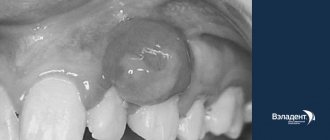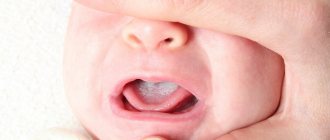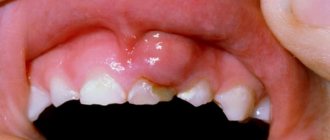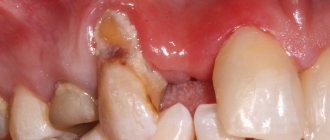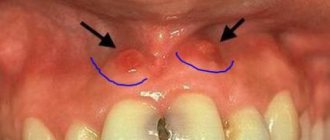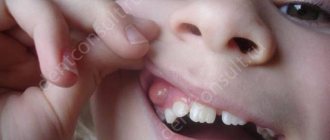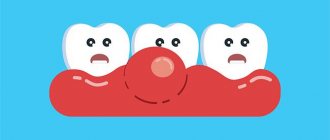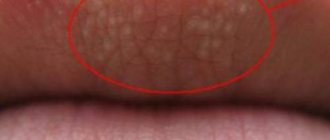For parents, the first days and months of a child's life are the most exciting. Every slightest deviation from the norm in a child’s health during a given period can cause serious concern, since the baby’s body is very vulnerable, and the range of treatment methods is very limited. Even the slightest cold is fraught with serious consequences. One of the problems that new parents often face is the formation of white pimples on the child’s gums. If your baby has a small, light-colored nodule, you need to consult a pediatric specialist. Only a specialist can determine the causes and origin of the pathology. More often than not, white pimples on a baby’s gums are a harmless phenomenon, but sometimes they still signal a progressive disease that needs quality treatment.
White pimples on the gums are not a pathology
Only a pediatric dentist can convince worried parents that there is no need to worry and that white spots in the child’s mouth are not an anomaly. Below we consider phenomena that are not dangerous to children's health:
- Bohn's nodules are small whitish formations that appear on the upper or lower gums. They are cysts in nature, but they do not pose a danger to the baby’s health. Over time, the nodules will go away on their own. In some cases, parents may mistake such formations for teeth that are beginning to erupt.
- Epstein's pearls look like small spots and are often located on the palate. This phenomenon also cannot be treated, since it does not pose a threat. The pearl oyster will go away on its own.
Whitish spots may be the remains of food that the baby consumed and then regurgitated. They should go away on their own within a short period of time because they are washed away by saliva. If the plaque does not go away for a long time, this is a reason to contact an experienced specialist.
Treatment of formation in the oral cavity
If a cyst is detected early, there is a small chance that surgery can be avoided.
Drug therapy
Doctors offer the following drug treatment regimen for cysts:
- treating the shell with a special antiseptic;
- deep tooth cleaning;
- filling.
The dentist removes pus from the cyst and fills the resulting area with a special paste that can restore damaged tissue. Next, a filling is installed, and for several months nothing bothers the patient
After the specified period, it is important to carry out diagnostics to establish the fact of complete disposal of the cyst.
Drug therapy can only help if several conditions are met:
- there are no fillings on the root canals or the filling is partially done;
- the cyst reaches small sizes (no more than 8 mm in diameter).
Sources
- https://kistaplus.ru/vo-rtu/kista-na-nebe-vo-rtu.html
- https://pipdecor.ru/kista-vo-rtu-na-nebe/
- https://stoma.guru/polost-rta/desny/kista-na-desne-simptomy-lechenie-foto.html
- https://vseokiste.ru/rot/kista-vo-rtu.html
- https://denta.help/detskaya/u-rebenka-na-desne-kista-77
- https://www.pro-zuby.ru/parodontologiya/polost-rta/kista-vo-rtu.html
What phenomena are considered serious?
There are a number of pathological reasons that explain the appearance of pimples on a child’s gums. Thrush often occurs in infants due to a weak immune system. In appearance, thrush resembles cheesy whitish soft deposits. In infants, pathology can occur as a result of transmission of the fungus from the mother. The weak immunity of infants is not yet able to resist such infections.
White plaque on the lower or upper gums can appear under the influence of unfavorable factors:
- Prematurity.
- Allergy.
- Metabolic disease.
- Poor quality food.
- Inflammation in the body.
- Sick intestines as a result of microflora disturbance.
In the cases listed above, whitish dots may form on the mucous membrane, so the child should be shown to a doctor without fail.
How to treat
The doctor’s tactics when detecting white spots on a child’s gums will depend on their cause.
For stomatitis
If the cause of white spots on the gums is aphthous stomatitis, it is important to give the child plenty of fluids, rinse the mouth, humidify the air in the room and change the baby’s menu (give warm, fresh liquid or pureed food). The doctor may prescribe the child antihistamines, antibacterials, multivitamins, immunomodulatory or antiviral medications. Local treatment of aphthae is carried out with analgesic gels and antiseptic solutions
If white spots appear as a result of herpes stomatitis, it is important to isolate the child from other children, since this disease is highly contagious. The room in which the baby is located is constantly ventilated, and dishes and towels should be separate. For treatment, you should consult a doctor so that he can prescribe an antiviral agent that is effective for such stomatitis. Additionally, the treatment uses gels with an anesthetic effect and frequent rinsing with herbal decoctions and antiseptics. If changes in the gums are associated with candidiasis infection, it is important to numb the affected areas of the gums, change the baby’s diet (exclude hard, sour and hot foods) and rinse the mouth with a soda solution. If this form of stomatitis is confirmed, the doctor will prescribe antifungal medications based on fluconazole or nystatin
Local treatment of aphthae is carried out with analgesic gels and antiseptic solutions
If white spots appear as a result of herpes stomatitis, it is important to isolate the child from other children, since this disease is highly contagious. The room in which the baby is located is constantly ventilated, and dishes and towels should be separate
For treatment, you should consult a doctor so that he can prescribe an antiviral agent that is effective for such stomatitis. Additionally, the treatment uses gels with an anesthetic effect and frequent rinsing with herbal decoctions and antiseptics. If changes in the gums are associated with candidiasis infection, it is important to numb the affected areas of the gums, change the baby’s diet (exclude hard, sour and hot foods) and rinse the mouth with a soda solution. If this form of stomatitis is confirmed, the doctor will prescribe antifungal medications based on fluconazole or nystatin.
What aphthous stomatitis is, how to treat and recognize it, can be seen in the following video.
https://youtube.com/watch?v=uHT04k_5eWs
With a cyst
When a cyst filled with pus appears near a baby tooth, it is often removed, after which the baby is prescribed antibacterial agents and rinses. If the tooth under which the cyst is located is permanent, the doctor will try to save it. He will dissect the cyst and remove part of the tooth root along with it, after which he will install a filling.
What should parents be wary of?
- Candidiasis – whitish small ulcers appear in the baby’s mouth. They are usually covered with a whitish, cheesy coating. There is a sour smell from the mouth, and the body temperature may rise. The sores can be painful and itchy, causing babies to become restless.
- Bacterial stomatitis - small pimples on the gums and inner surface of the cheeks, heavy plaque - these are the main symptoms of the disease. An increase in temperature and deterioration in general condition may also occur.
- Viral infections. Symptoms are similar to those of bacterial stomatitis. Spots on the upper and lower gums and tongue visually resemble small watery blisters.
- Non-infectious stomatitis. It may manifest itself as a consequence of anemia and lack of vitamins. Also, a similar form of stomatitis occurs after the baby is weaned. Small spots are accompanied by pallor of the skin, the baby eats little and does not gain weight well.
- Cyst. This is a serious problem caused by bacterial infections. The symptom is an accumulation of pus. A fistula may develop from the cyst, through which purulent exudate emerges.
Infectious diseases of the oral cavity
The appearance on a baby's gum of a white spot, similar to a pimple, slightly rising above the surface, may be a symptom of one of the infectious diseases. Most often these are stomatitis of various etiologies.
Disease Signs Cause Herpes White dot on the gum of a baby, new white lumps. The color gradually changes to yellowish. The baby has a high temperature, is not eating well, and is clearly experiencing unpleasant and painful sensations. Infection occurs when communicating with patients or carriers of the virus, using their things
A mother needs to be very careful if she has an exacerbation of herpes: be sure to wear a mask on her face to protect the baby from saliva, wash her hands thoroughly, and treat nipples with disinfectants when breastfeeding. Dishes, pacifiers and pacifiers must be sterilized especially carefully
It is forbidden to try food from children's plates (many mothers do this, forgetting that they can introduce a serious infection into the baby's body). Herpes not only threatens the health of the child, its complications can cause the death of the baby. Thrush A few white bumps on the gums, tongue, or roof of the mouth that resemble grains of cottage cheese may indicate a fungal infection. The baby becomes restless and loses his appetite. In addition, Candida fungus can enter the stomach and intestines, which will cause increased gas formation and abdominal pain. Infection occurs when passing through the birth canal. A baby can be infected even after birth if the hygiene rules for mother and child are not followed and toys and rattles, clothes and bedding are not disinfected. The body can defeat a fungal infection on its own, but extremely unpleasant consequences are also possible, so it is better to seek professional help. Other infections caused by opportunistic bacteria If a child has a fever, he refuses water and food, is capricious, a purulent white pimple, next to which several others soon appear, is one of the symptoms of an infectious lesion in the oral cavity. After 1–2 days, a purulent vesicle appears, and then an ulcer with white edges. The cause of infection is failure to comply with hygiene rules, contact with sick children or adults, or the use of household items of patients or carriers of viruses.
Any infection is dangerous for the baby. The appearance of one or more spots cannot be ignored. If the baby’s gums turn white, there is plaque or pimples on them, the mother should definitely contact a pediatrician for advice and start treatment as early as possible - in the initial stages, stomatitis is much easier to treat.
What is the danger of candidiasis and how to prevent it
Babies under the age of six months are especially susceptible to the disease. Fungi from the genus Candida contribute to the development of pathology. Obvious symptoms are the formation of a white coating, which is accompanied by inflammation and the appearance of spots. With severe lesions, the spots may begin to bleed. In their advanced form, the spots resemble a fairly strong and dense film that completely covers the oral cavity. As a result, cracks appear, causing further slight bleeding. On many sites and forums you can familiarize yourself in detail with the pathology from the photo. Babies, when eating and swallowing, experience pain, become lethargic and capricious. The temperature may rise. In case of such damage, it is necessary to show the child to a pediatric dentist as soon as possible. Ways to prevent illness:
- After each breastfeeding, you should give your baby a drink of warm water. The liquid will remove any remaining milk in your mouth.
- Mothers should wash their hands thoroughly and maintain good body hygiene.
- If the disease has already been cured, do not allow it to recur. Regularly treat children's accessories with boiling water.
Preventive measures must be taken to ensure that pimples on the gums no longer appear. Avoid sugary drinks as they can trigger a recurrence of thrush as fungi multiply quite quickly in such an environment.
Treatment methods
The choice of treatment method depends on the nature and nature of the rash and the degree of damage to the oral cavity. Therapy is aimed at relieving pain, treating the cause of acne, and relieving inflammation of the affected tissues. Based on the examination data, the child may be prescribed:
- local painkillers and antiviral drugs - Arbidol, Vinilin, Solcoseryl;
- antipyretics in the form of syrups and suppositories (Nurofen, Efferalgan);
- antiallergic drugs (Zodak, Erius, Tavegil);
- antibiotics (Lincomycin, Augmentin, others);
- rinsing with a solution of Miramistin, Chlorophyllipt, Stomatofit, tinctures of calendula, propolis or chamomile;
- antifungal medications (Diflucan).
Additionally, a course of physiotherapy is prescribed, aimed at eliminating the symptoms of the disease and preventing its relapses. The effects of a magnetic field, laser, ultrasound, aerosol therapy, and treatment with mineral waters are indicated. For aphthae in the mouth, darsonvalization and electrophoresis with magnesium provide a good effect. To prevent relapses of the disease, a healthy lifestyle, moderate physical activity, and taking vitamin and mineral complexes in winter are recommended.
Lack of timely treatment of white rashes in the mouth leads to the following unpleasant complications:
- the child’s weight loss, weakness, low hemoglobin due to refusal to eat;
- decreased immunity, which increases the risk of contracting a viral infection;
- destruction of enamel;
- diseases of teeth, gums.
Features of treatment for children with small pimples on the gums
Whatever the diagnosis, dad and mom should be very careful. It is necessary to understand that self-medication of an infant is fraught with dangerous consequences. Once the reasons for the formation of pimples on the upper or lower gums have been accurately determined, the recommendations of the pediatrician should be strictly followed. The treatment method will depend on the diagnosis:
- Plaque must be carefully removed using a regular gauze pad.
- For thrush and infectious stomatitis, it is necessary to eliminate the cause of the disease. Only a doctor can accurately determine the nature of the disease and correctly prescribe medication. It is important to understand that viruses can only be effectively treated with antiviral drugs. To eliminate diseases caused by streptococci and staphylococci, antibacterial drugs will be needed. For fungal infections, antifungal drugs are prescribed.
If white pimples appear on the gums and the baby’s body temperature quickly rises, you need to monitor the water balance and let the baby drink as much as possible. Hot drinks are not recommended; it is better to drink the child with plain clean water. If necessary, you can give your baby an antipyretic, after consulting with your pediatrician. If the dentist diagnoses a malignant tumor, surgical intervention will be required. For Epstein pearls, no treatment is necessary; small spots will go away on their own. To avoid complications and recurrence of the problem, parents should monitor the condition of their children's oral cavity. In the autumn-spring period, children are more vulnerable to colds and viral diseases, which can cause problems.
Plaque as a symptom of stomatitis
One of the possible reasons for the appearance of white spots, pimples or plaque in the baby’s mouth, as mentioned earlier, is stomatitis. For example, in the case of yeast (fungal) stomatitis, plaque or spots on the tongue and gums resemble cottage cheese. The course of the disease is accompanied by increased moodiness of the child and refusal to eat.
Stomatitis can be provoked by:
- emotional stress;
- viral infection;
- food poisoning;
- inflammatory process;
- weakened maternal immunity;
- mother taking antibiotics.
Candidal stomatitis in infants
The mucous membrane of infants is still very sensitive and susceptible to infections. One of the ways kids learn about the world is to taste everything. They put a lot of things in their mouths and can easily become infected. Also, if they simply bite their cheek, a wound will form, and germs can easily penetrate there too.
Doctors distinguish several types of stomatitis:
- Viral. It occurs against the background of infectious diseases, which in turn are caused by viruses. For example, herpes, measles, chickenpox, scarlet fever, otitis media.
- Fungal. It is also called thrush. It can be caused by the Cand fungus >
Despite the fact that the abscess can burst on its own, the source of infection will remain, as a result, any irritating factor can trigger the accumulation of pus again. If the abscess is not removed in time, the spread of infection and complications can be very serious.
It is important not to put off visiting a doctor
Effective therapy consists of an integrated approach, namely the prescription of antibacterial drugs, opening of purulent formation, physiotherapy procedures, rinsing and oral care. Removing an abscess is a surgical procedure that should be performed in a clinic by an experienced specialist.
However, in order to alleviate the pain in a child before being examined by a doctor, you can resort to some measures:
- Cool the sore gum. As a result, swelling and pain will decrease.
- Rinse or lubricate your mouth with antiseptic solutions. For example, a weak solution of potassium permanganate, furatsilin or a decoction of medicinal plants.
- Eat warm liquid food.
- Provide plenty of fluids. It will reduce intoxication.
- Use a pain reliever if necessary. For example, Paracetamol or Nurofen, allowed from 3 months.
It is also important not to take actions that can harm and aggravate the situation, namely:
- perform an autopsy yourself;
- warm with a hot compress in the area of the abscess;
- stop oral care;
- do hot rinsing with decoctions;
- use medications not prescribed by a doctor.
What rules should you remember?
Babies under one year old are very vulnerable to external factors that carry great health risks. Every mother should be able to accurately determine the pathology and process of teething. If you detect the slightest violation, you should immediately seek help. What rules must be followed:
- Your baby's dishes and toys should be perfectly clean. To maintain cleanliness, you can rinse them with boiling water or wash them with baking soda.
- Establish a proper diet.
- Treat any diseases in a timely manner.
- Improve the functioning of the immune system in every possible way.
- If a small pimple appears in the mouth or a spot appears that does not go away on its own, there is no need to self-medicate, you should immediately go to the pediatrician.
- Nursing mothers are advised to completely exclude foods that are harmful to the baby from their diet. Salt and sugar can negatively affect the baby's health.
- After each feeding, carefully and carefully clean the baby's mouth so as not to damage the mucous membrane and cause pain to the baby.
- For the first teeth, special accessories are used for cleaning and oral hygiene.
- Remember: using pacifiers for too long can negatively affect the development of the bite and provoke early caries of baby teeth.
- No matter how old the child is, he should visit the pediatric dentist regularly.
- Do not try to cure gum pimples on your own.
Causes of white plaque in a child:
- Failure to comply with personal hygiene standards. After breastfeeding, the remains of mother's milk remain on the gums for some time. This can lead to the growth of bacteria, so it is advisable to wipe the oral cavity with clean, damp gauze after feeding;
- Lack of calcium. Not every woman can boast that her milk is 100% quality. It is not uncommon that colostrum does not have the full range of vitamins and microelements. Most often this happens if a woman has bad habits (smoking, alcohol, unhealthy food);
- Stomatitis. Violation of the normal structure of the oral mucosa may indicate a lack of iron, folic acid, and vitamins in the body. The disease can also be caused by viral infections and emotional stress.
Course of therapy
Moms and dads should understand that buying medications on their own and giving them to infants is strictly prohibited. Many tablets, ointments and gels are contraindicated for children. You can treat your baby only with the drugs that your pediatric dentist recommends. After the baby has eaten, you can give him one tablespoon of clean water, this will help get rid of food residues on the tongue. Before each feeding, the mother should wash her breasts well. It is not advisable to use aromatic shower gels. Also, some doctors recommend that nursing mothers wash their breasts with a weak soda solution. The drug Candide effectively helps with thrush. If the pediatrician determines that the baby has vitamin deficiency, he will prescribe the necessary medications and suggest that the mother reconsider her diet. Such remedies as Nurofen or Panadol will help relieve fever and relieve pain. Acyclovir is popular among antiviral drugs. If the bumps are filled with pus, the doctor will prescribe antibiotics. Among folk remedies, decoctions and infusions of calendula, chamomile and sage work well. Before adding a traditional method to your course of therapy, you must consult with a specialist.
How to treat white pimples?
- White pimples do not require special treatment. In this case, the so-called “policy of non-intervention” will be much more useful, when you want to treat, but you shouldn’t do it
- Do not squeeze pimples under any circumstances, you may cause an infection or provoke an inflammatory process.
- Do not rub your baby’s delicate skin with all kinds of alcohol-containing lotions and creams.
- Wash your newborn or baby with boiled water
- You can bathe your child in a weak, barely pink solution of potassium permanganate - this will help dry the skin
- Brew chamomile or string for bathing. Be careful - some babies may be allergic to some types of herbs
- It is recommended to give the baby air baths more often, if the room temperature allows
- Change clothes and diapers on time
- If you are breastfeeding, try to stick to your diet, do not eat red foods or citrus fruits. Excess sweets can also lead to breakouts
Reasons for the appearance of pimples on the gums of an adult
Adults are also susceptible to the appearance of various formations in the oral cavity. Pathogenic microflora develops very quickly in the oral cavity of an adult. You should be wary of such formations as:
- Small pimples concentrated throughout the mouth.
- A single pimple on the gum.
- Fistula around a tooth.
In adults, white pimples occur for the same reasons as in children. In modern dentistry, there are many reasons for the development of diseases:
- Bad habits.
- Lack or improper oral hygiene, which leads to the active proliferation of bacteria.
- Poor nutrition, sugar abuse.
- Chronic and untreated diseases.
- Long-term use of potent medications.
In adults, rashes may indicate the presence of herpes. A small red rash indicates an allergy. You should not try to eliminate a pimple on your own. Do not pierce ulcers with needles or other sharp objects. This can lead to infection. It is also not recommended to heat formations in the oral cavity.
Since it is quite difficult to independently identify and eliminate the cause of diseases, it is necessary to immediately contact a specialist at the first signs.
Causes
In a recently born child, the mucous membrane has a pale pink tint, and the gums are smooth, without bumps or lesions. Sometimes they become covered with a light coating, which causes anxiety in the young mother.
The following factors are common and do not harm the child:
- Bohn's nodules - tiny “pearls” are cysts formed from glandular tissue. White dots do not cause discomfort to the baby and disappear on their own over time;
- Einstein's pearls are clusters of epithelial cells, absolutely painless, that appear in the first weeks of a baby's life and disappear spontaneously;
- teeth – sometimes children are born with teeth that have erupted, this does happen, albeit rarely.
There are several reasons leading to the appearance of white spots:
- violation of the rules of oral care - includes neglecting the treatment of gums after feeding, this is especially true when consuming formula milk;
- vitamin deficiency - when a nursing woman does not take care of the completeness of her diet, this can make her milk unnutritious;
- low calcium – mothers who smoke and have bad habits often have insufficient levels of this microelement in the body, which affects the child’s health;
- thrush - occurs due to a fungal infection and looks like a cheesy coating on the gums.
When an adult or child often has problems with the health of the oral cavity: stomatitis aphthae form, lips become inflamed and peeling, there are signs of candidiasis, desquamative glossitis, and the patient also loses weight, complains of poor health, and has serious disturbances in the functioning of internal organs , then such a clinical picture can raise suspicion of HIV.
In an adult, a light plaque in the mouth often occurs after tooth extraction. There is no need to panic when there are no symptoms of inflammation, and you notice that the hole of the extirpated tooth is covered with a light gray film - these are accumulations of fibrin, which is formed during the healing process of the wound.
Reason No. 2. Bon's knots
White dots on the gums of a baby, as in the photo below, are Bon's nodules. A person who is not related to medicine is unlikely to be able to distinguish them from Epstein’s pearls outwardly, especially since they also consist of keratinized epithelium, but they take longer to disappear - within 3 months after birth. Benign and completely painless nodules got their name in honor of the famous German pediatrician who first described this phenomenon back in 1886.
Bohn's nodules consist of keratinized epithelium
Home remedies for white spots
In addition to using professional techniques, the dentist will advise you on how to remove white spots on teeth at home. This is, firstly, a balanced, healthy diet - fewer carbohydrates, especially simple ones, more vegetables, fruits, berries, and dairy products. Secondly, brushing your teeth with remineralizing paste and using remineralizing gels.
Such pastes contain an increased amount of substances that promote tooth remineralization. You should not select these products yourself or use them constantly. The duration of the course of home remineralizing remedies is determined by the dentist.
Remineralizing products are divided into several types:
- fluoride-containing pastes - not suitable for fluorosis, but effective in other cases;
- nanohydroxyapatite is a synthesized substance identical to that which is part of enamel and dentin. It is useful for caries at the white spot stage, closes microcracks and eliminates tooth hypersensitivity;
- amorphous calcium phosphate - forms a thin protective film on the enamel, thereby reducing the negative effects of acids and strengthening tooth tissue. Calcium phosphate gels should be applied after brushing with paste for 1-2 minutes per day.
Comments
My child has developed a white dot on his gum right next to his front baby tooth. The teeth are healthy, without holes, the child is 7 years old. What could it be?
Alexey (08/02/2020 at 00:22) Reply to comment
- Dear Alexey, perhaps your child’s permanent tooth has begun to erupt, and since the baby tooth has not yet fallen out, it simply does not have enough space and has changed the direction of growth. In this case, the baby tooth will have to be removed, otherwise there is a risk that the permanent tooth will move into the second row or will be severely curved, and the bite may be disrupted. Contact your pediatric dentist to clarify the situation and agree on a further plan of action.
Editorial staff of the portal UltraSmile.ru (08/04/2020 at 09:12) Reply to comment
I still don’t understand whether it is possible to independently treat a child if such a white spot occurs. After all, it usually goes away quickly when you spread it with brilliant green.
Alisa (08/21/2020 at 06:38) Reply to comment
Stomatitis will probably be treated in a baby with some safe ointments or pastes? Are such remedies completely safe for children or can they offer another method of treatment?
Olga (08/21/2020 at 08:56) Reply to comment
Hello, my child is 5 years old, the front tooth is much lighter than the rest, it is very noticeable (the rest of the teeth are normal white, but the front one is just snow-white.) Tell me, what is this connected with and what to do?
Vladimir (08/21/2020 at 08:58) Reply to comment
Recently we were talking to a girl on the playground and she said that her daughter often has stomatitis. I would like to know if this is contagious to other children? After all, they play with the same toys and can transmit bacteria through them.
Olga (08/21/2020 at 09:35) Reply to comment
Hello! Thanks for the useful article. After reading the article, I thought about it: my son had small dots right on his gums with a size of 0.5 mm, very small. I thought it was teething and didn’t pay much attention. The teeth are cutting through, everything is fine, thank God. I have a question: can such dots just appear before teething? Or should I also contact a pediatrician or dentist?
Kamila (08/21/2020 at 10:56 am) Reply to comment
My son has white spots on his gums and mucous membranes, has a slight fever, eats poorly, he is 1 year and 2 months old. It looks like stomatitis. Can I buy medicine for stomatitis at the pharmacy, or is it better to go to the dentist?
Olesya (08/21/2020 at 11:08 am) Reply to comment
Could white spots be an allergic reaction of the baby to spicy and salty foods in the diet of a nursing mother? The habit of generously salting and peppering food has been around for many years. For now, I’m trying to eat more neutral in taste, but sometimes I break down.
Alina (08/21/2020 at 11:26 am) Reply to comment
Why did my one-month-old baby start to have white spots on his gums, although this had never happened before? What measures would you recommend to take in this case and will these white dots harm the child?
Laima (09.23.2020 at 14:43) Reply to comment
How can white pimples on the gums and oral mucosa cause harm? These white spots have been formed for several weeks; what should the baby’s oral cavity be treated with to get rid of them?
Tanya (09.23.2020 at 14:45) Reply to comment
Tell me, can these white spots on the gums cause stomatitis in an infant? How to treat these white spots in a baby if the child is still breastfed?
Kira (09.23.2020 at 15:29) Reply to comment
The child suffers greatly due to the appearance of small white spots on the gums, as well as on the inside of the cheek. In appearance, these white dots look like leftover milk from a baby; they cannot be removed with a cotton swab; the child is constantly capricious. Please advise what can be done to rid the child of these white spots in the mouth?
Lyudmila (09.23.2020 at 15:41) Reply to comment

